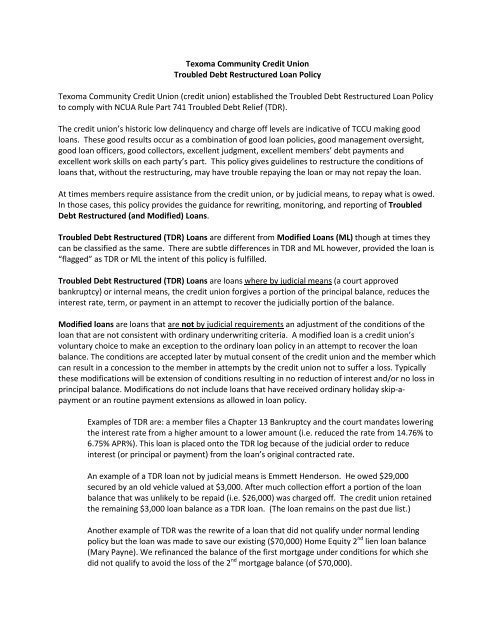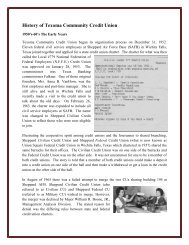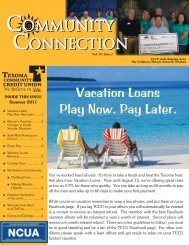Texoma Community Credit Union Troubled Debt Restructured Loan ...
Texoma Community Credit Union Troubled Debt Restructured Loan ...
Texoma Community Credit Union Troubled Debt Restructured Loan ...
Create successful ePaper yourself
Turn your PDF publications into a flip-book with our unique Google optimized e-Paper software.
<strong>Texoma</strong> <strong>Community</strong> <strong>Credit</strong> <strong>Union</strong><br />
<strong>Troubled</strong> <strong>Debt</strong> <strong>Restructured</strong> <strong>Loan</strong> Policy<br />
<strong>Texoma</strong> <strong>Community</strong> <strong>Credit</strong> <strong>Union</strong> (credit union) established the <strong>Troubled</strong> <strong>Debt</strong> <strong>Restructured</strong> <strong>Loan</strong> Policy<br />
to comply with NCUA Rule Part 741 <strong>Troubled</strong> <strong>Debt</strong> Relief (TDR).<br />
The credit union’s historic low delinquency and charge off levels are indicative of TCCU making good<br />
loans. These good results occur as a combination of good loan policies, good management oversight,<br />
good loan officers, good collectors, excellent judgment, excellent members’ debt payments and<br />
excellent work skills on each party’s part. This policy gives guidelines to restructure the conditions of<br />
loans that, without the restructuring, may have trouble repaying the loan or may not repay the loan.<br />
At times members require assistance from the credit union, or by judicial means, to repay what is owed.<br />
In those cases, this policy provides the guidance for rewriting, monitoring, and reporting of <strong>Troubled</strong><br />
<strong>Debt</strong> <strong>Restructured</strong> (and Modified) <strong>Loan</strong>s.<br />
<strong>Troubled</strong> <strong>Debt</strong> <strong>Restructured</strong> (TDR) <strong>Loan</strong>s are different from Modified <strong>Loan</strong>s (ML) though at times they<br />
can be classified as the same. There are subtle differences in TDR and ML however, provided the loan is<br />
“flagged” as TDR or ML the intent of this policy is fulfilled.<br />
<strong>Troubled</strong> <strong>Debt</strong> <strong>Restructured</strong> (TDR) <strong>Loan</strong>s are loans where by judicial means (a court approved<br />
bankruptcy) or internal means, the credit union forgives a portion of the principal balance, reduces the<br />
interest rate, term, or payment in an attempt to recover the judicially portion of the balance.<br />
Modified loans are loans that are not by judicial requirements an adjustment of the conditions of the<br />
loan that are not consistent with ordinary underwriting criteria. A modified loan is a credit union’s<br />
voluntary choice to make an exception to the ordinary loan policy in an attempt to recover the loan<br />
balance. The conditions are accepted later by mutual consent of the credit union and the member which<br />
can result in a concession to the member in attempts by the credit union not to suffer a loss. Typically<br />
these modifications will be extension of conditions resulting in no reduction of interest and/or no loss in<br />
principal balance. Modifications do not include loans that have received ordinary holiday skip-apayment<br />
or an routine payment extensions as allowed in loan policy.<br />
Examples of TDR are: a member files a Chapter 13 Bankruptcy and the court mandates lowering<br />
the interest rate from a higher amount to a lower amount (i.e. reduced the rate from 14.76% to<br />
6.75% APR%). This loan is placed onto the TDR log because of the judicial order to reduce<br />
interest (or principal or payment) from the loan’s original contracted rate.<br />
An example of a TDR loan not by judicial means is Emmett Henderson. He owed $29,000<br />
secured by an old vehicle valued at $3,000. After much collection effort a portion of the loan<br />
balance that was unlikely to be repaid (i.e. $26,000) was charged off. The credit union retained<br />
the remaining $3,000 loan balance as a TDR loan. (The loan remains on the past due list.)<br />
Another example of TDR was the rewrite of a loan that did not qualify under normal lending<br />
policy but the loan was made to save our existing ($70,000) Home Equity 2 nd lien loan balance<br />
(Mary Payne). We refinanced the balance of the first mortgage under conditions for which she<br />
did not qualify to avoid the loss of the 2 nd mortgage balance (of $70,000).
The credit union establishes the following eligibility requirements to be approved for a TDR or ML.<br />
1. The member’s loans must be restructured due to a judicial order (bankruptcy order).<br />
2. The member petitions the credit union for a restructured loan and has had one or more of the<br />
following circumstances occur circumstances, such as but not limited to:<br />
a. job loss by the member or joint member,<br />
b. divorce of a member or joint member that caused a sufficient loss of household income,<br />
c. death of a member or joint member that caused a sufficient loss of household income,<br />
d. other substantial life event, of which any of these may have resulted in the member’s<br />
inability to continue making payments as per the original or existing loan documents.<br />
3. The first time a TDR or ML loan is requested it may be approved. It is unlikely that a second TDR<br />
or ML requested will be approved unless the member has had subsequent unpreventable<br />
circumstances occur. A third TDR or ML will not be considered without material improvements<br />
in conditions that the member offers; such as added collateral, co-signer, etc.<br />
4. The Chief Lending Officer (CLO) must personally, face-to-face, interview all parties requesting<br />
the TRD or ML loan unless prohibited by the court.<br />
a. The CLO must be convinced that the borrower has a strong willingness to repay and the<br />
member has demonstrated reasonable ability to repay the loan under the new terms.<br />
b. The member should (not must) attend Dave Ramsey Financial Peace classes and to<br />
provide a certificate of completion before future concessions or extensions of credit<br />
occur.<br />
c. A second or third TDR or ML request will be denied if the member(s) have not attended<br />
the Dave Ramsey Financial Peace classes.<br />
d. The CLO must provide a written petition to the president/CEO to convince the CEO to<br />
approve the TDR or ML.<br />
e. The TDR or ML must not include any “unpaid accrued interest more than 90 days past<br />
the due date” in the principal, nor shall interest over 90 days be charged to the member.<br />
f. No fees are to be paid or financed to obtain the TDR or ML.<br />
g. The borrower may be charged a “forced placed” insurance policy using the ordinary<br />
conditions for the forced placed premium such as single interest insurance premiums,<br />
real estate taxes owed, property insurance, credit life or credit disability insurance and<br />
other such charges. If necessary the president may extend the term of the loan to pay<br />
the forced placed expenses if recommended by the CLO. Alternatively, the CLO may<br />
recommend and the president may order a repossession of the collateral in lieu of<br />
adding the cost of the premium to the loan.<br />
h. The administrative fees earned from <strong>Credit</strong> Life and <strong>Credit</strong> Disability insurance<br />
premiums or Single Interest Insurance is exempted from 4.g above because it is<br />
economically impossible to calculate those administrative fees.<br />
5. Only the President/CEO may approve a TDR or ML. A loan is classified as a TDR or ML when:<br />
a. The action needed reduces interest rate to a rate that is less than the traditional APR for<br />
which the member’s credit score qualifies; or<br />
b. The restructuring reduces principal and write off a portion of the loan balance owed; or<br />
c. The action extend the terms to an amount greater than underwriting qualifies; or<br />
d. Other material concessions vary from standard loan underwriting criteria.
e. The member proves that he or she has lost sufficient income that will no longer allow<br />
them to repay the remaining balance under the original terms and conditions.<br />
Events causing temporary or permanent inability to repay, and not unwillingness to repay the debt are<br />
situations where a TDR may be considered. To consider the TDR or ML the member shall:<br />
1. Supply a new completed loan application; and<br />
2. Fund the loan on closed end documents; and<br />
3. Provide proof of income or tax returns; and<br />
4. Provide any other documentation requested by CLO or CEO.<br />
The CLO shall determine from communications with the member, the member’s willingness and their<br />
ability to repay. Upon determining there is a willingness and the ability to repay, the President at his sole<br />
discretion will:<br />
1. set the interest rate at which the loan will be repaid, at his sole discretion;<br />
2. If necessary, reduce the principal through charge off;<br />
3. Extend the terms of the loan;<br />
4. Modify collateral required.<br />
Future money may be advanced to the member(s) on the remaining loan balance after one (1) year<br />
history of timely loan payments. Future loan advances are subject to the ordinary rates, terms, and<br />
conditions that apply according to the credit level and credit risk of the member. Member should<br />
provide a certificate of successfully completing a Dave Ramsey Financial Peace course to obtain future<br />
loan considerations.<br />
If the member’s life situation improves the member may repay any amount of unpaid principal lost.<br />
Regular underwriting requirements would be in place to make this decision by the President. In any<br />
case, no TDR or ML loan should have terms longer than those set in the credit union’s loan pricing matrix<br />
or loan policy, without President/CEO approval.<br />
The TDR and ML log shall be included semi-annually (June and December) in each month’s regular board<br />
packet for the board’s review of such loans. All loans placed in the TDR and ML log will remain classified<br />
as TDR or ML until the loan is not less than one year of payments without delinquency concerns, except<br />
for Member Business TDR or ML loans which remain on TDR or ML for not less than eternity.<br />
The <strong>Troubled</strong> <strong>Debt</strong> Relief (TDR) <strong>Loan</strong> Policy is approved this 21st day of June, 2012 at a duly called<br />
meeting of the Board of Directors.<br />
____________________________________<br />
Robert Russell, Chairman<br />
_______________________________________<br />
Marilyn Darnall, Secretary
"Minimum requirements consist of: (NCUA does not intend for these minimum requirements to be<br />
considered and all-inclusive list)<br />
1.) Define eligibility requirements (i.e. under what conditions the FICU will consider a loan workout),<br />
including establishing limits on the number of times an individual loan may be modified. [Note: Broadbased<br />
credit union programs commonly used as a member benefit and implemented in a safe and sound<br />
manner limited to only accounts in good standing, such as Skip-a-Pay programs, are not intended to<br />
count toward these limits.]<br />
2.) Ensure the FICU makes loan workout decisions based on the borrower's renewed willingness and<br />
ability to repay the loan.<br />
3.) Establish sound controls to ensure loan workout actions are appropriately structured, including a<br />
prohibition against any authorizations of additional advances to finance unpaid interest and credit union<br />
fees. The policy may allow a FICU to make advances to cover third-party fees, such as force-placed<br />
insurance or property taxes. The FICU, however, cannot finance any related commissions it may receive<br />
from the third party.<br />
4.) Ensure adequate controls and monitoring by the board of directors and management Decisions to<br />
re-age, extend, renew, of rewrite a loan, like any other revision to contractual terms, must be supported<br />
by the FICU's managements information system.<br />
5.) Ensure appropriate documentation showing the FICU's personnel communicated with the borrower,<br />
the borrower agreed to pay the loan in full, and the borrower has the ability to repay the loan under the<br />
new terms."






